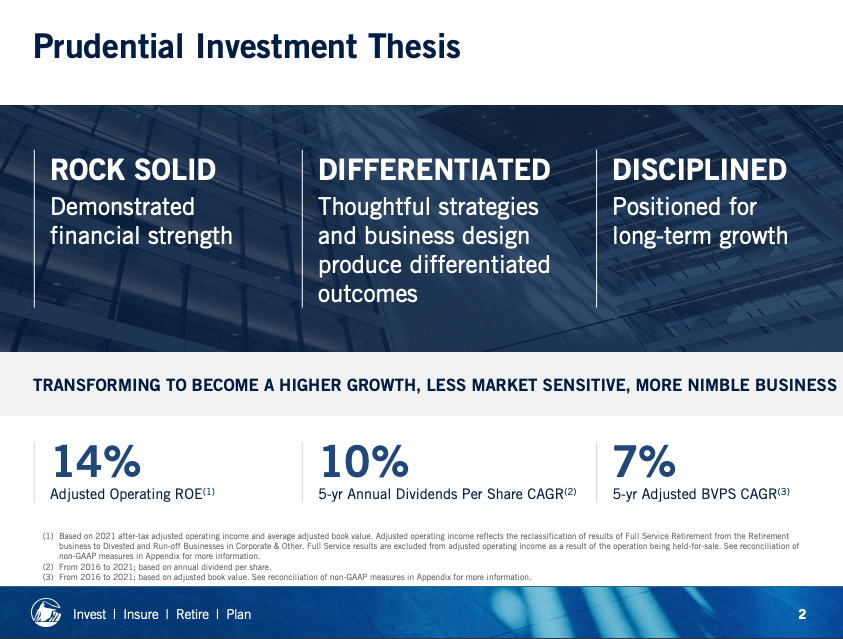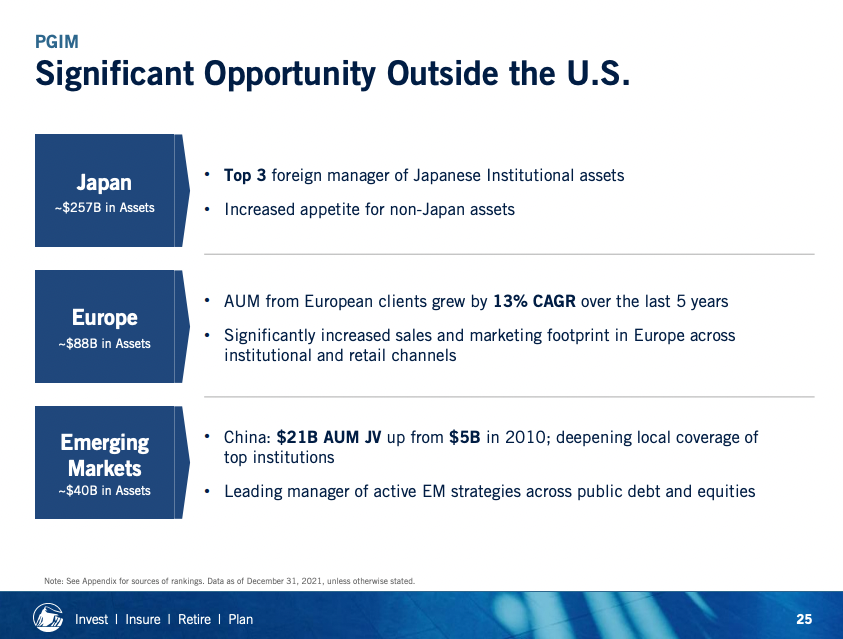High Dividend 50: Prudential Financial Inc.

Image Source: Pixabay
Prudential Financial Inc. (PRU) is a high dividend yield company. The company is a dividend contender, as it is a U.S. stock that has grown its dividends for 10-24 consecutive years.
Prudential has raised its dividend for fourteen straight years. We also cover a lot of other different high-yield stocks in our database. Here, we will review Prudential Financial Inc., as it has a dividend yield of 4.0%.
Business Overview
Prudential Financial Inc. has operations in the United States, Asia, Europe, and Latin America. The company provides customers with various products and services, including life insurance, annuities, retirement-related services, mutual funds, and investment management. Prudential Financial has now been in business for over 140 years with $1.7 trillion in assets under management (AUM).
Prudential operates in four divisions: PGIM (formerly Prudential Investment Management), U.S. Businesses, International Businesses, and Corporate & Other. The company trades with a $45.4 billion market capitalization.

Source: Investor Presentation
On Feb. 3, 2022, the company reported fourth-quarter and full-year results for Fiscal Year (FY) 2021. The company had strong financial results for the growth quarter and full year. In this period, the company made significant progress in becoming a higher growth, less market sensitive, and more agile company.
For the quarter, Prudential reported a net income of $1.208 billion, or $3.13 per share, compared to $819 million, or $2.03 per share, in Q4 2020. This is an increase of 54.2% year-over-year. After-tax operating income equaled $1.227 billion, or $3.18 per share, compared to $1.13 billion, or $2.80 per share, in Q4 2020, or an increase of 13.6%.
On a book value per common share, the company reported $161.26 versus $167.81 per share for the year ago period. AUM grew slightly for the quarter by 1.2%, compared to Q4 2020.
The company reported a total operating income of $7.3 billion for the entire year compared to the $4.95 billion the company made in FY 2020. This is an increase of 47.5% year-over-year. The PGIM segment saw growth of 30.2%, while the U.S. businesses segment saw growth of 43.4%.
For the year, Prudential generated a net income of $7.724 billion, or $19.51 per share, compared to a loss of $374 million, or a loss of $1.00 per share, in 2020. However, 2020 included significant investment losses. Adjusted after-tax operating income equaled $5.772 billion, or $14.58 per share, compared to $3.913 billion, or $9.72 per share, for 2020.
The company also entered into agreements to divest lower growth and more market-sensitive businesses throughout last year. The divestments will help the company perform and prepare much better for the next recession.
Overall, the company earned $14.58 per share for the entire year, which is an increase of 43% compared to FY 2021. We expect the company to earn $12.50 per share for FY 2021. This would denote a decrease of 14.3%. This would be mostly driven by the slowdown of the market.
Growth Prospects
Prudential growth prospects may come from programmatic acquisitions and investments in asset management and emerging markets. For example, the company acquired Montana Capital Partners, Green Harvest Asset Management, and ICEA LION Holdings.
While these are excellent acquisitions, Prudential is also divesting heavily market-sensitive assets. These divestments will help stabilize the company during the next recession. Thus, making the dividend safer.
Another growth driver for the company would be outside the U.S. As you can see below, AUM from European clients grew 13% CAGR over the last five years. China may also serve as a significant opportunity for the company.

Source: Investor Presentation
Competitive Advantages & Recession Performance
Prudential Financial does not necessarily have competitive advantages. Life insurers do not benefit from favorable competitive positions. The industry competition is fierce, and the products are commoditized in many cases. Furthermore, insurers do not know the cost of goods sold for several years, allowing them to under-price policies without knowing it.
During the Great Recession, the company took a hard earnings hit in 2008, with an earnings decline of 65%. The company also had to cut the dividend because of the fast decrease in earnings that year. Prudential cut its dividend from $1.15 per share to $0.58 per share for a reduction of 49.6%. However, it rebounded very well in the following years after 2008.
PRU’s earnings-per-share throughout the Great Recession were as follows:
- 2007 earnings-per-share of $7.58.
- 2008 earnings-per-share of $2.69 (65% decrease).
- 2009 earnings-per-share of $5.58 (107% increase).
- 2010 earnings-per-share of $6.27 (12% increase).
As you see, the company performed decently during the 2008-2009 Great Recession. Both the earnings and dividend took high reductions in 2008, but they came to their previous levels in just about three years.
Dividend Analysis
As mentioned above, the company has a dividend growth history of fourteen consecutive years. The only reason why it is not longer than fourteen years is because of the Great Recessions in 2008. Other than that, the company has had a ten-year dividend growth rate of 12.2%. Over the past five years, PRU has had a dividend growth rate of 10.4%.
The combination of a high dividend yield with a high dividend growth rate makes Prudential Financial a desirable investment for dividend and income-driven investors. The most recent dividend increase was on Feb. 3, 2022, when Prudential declared a $1.20 quarterly dividend, marking a 4.3% increase.
The company also pays a high dividend which is very safe. In the past ten years, the highest dividend payout ratio was 43% in 2020. Based on our expected earning of $12.50 per share for FY 2021, this would give us a dividend payout ratio of 38%. Thus, the dividend is very safe and will most likely continue to grow in the foreseeable future.

Source: Investor Presentation
The company also has an outstanding balance sheet. The company has a 0.3 debt-to-equity ratio, which is excellent. Also, PRU has an S&P Credit Rating of “A.” The “A” credit rating is an investment-grade rating.
Thus, the balance sheet is excellent and should help the company withstand a recession without a dividend cut. Therefore, we think the dividend is very safe.
Final Thoughts
Overall, Prudential Financial has been a solid business over the years with a variety of positive attributes. The dividend is very safe and secure. The high dividend yield and the high dividend growth make PRU an attractive investment for dividend and income-driven investors.
We have created a spreadsheet of stocks (and closely related REITs and MLPs, etc.) with dividend yields of 5% or more. You can download your free full list of all securities with 5%+ yields (along ...
more


